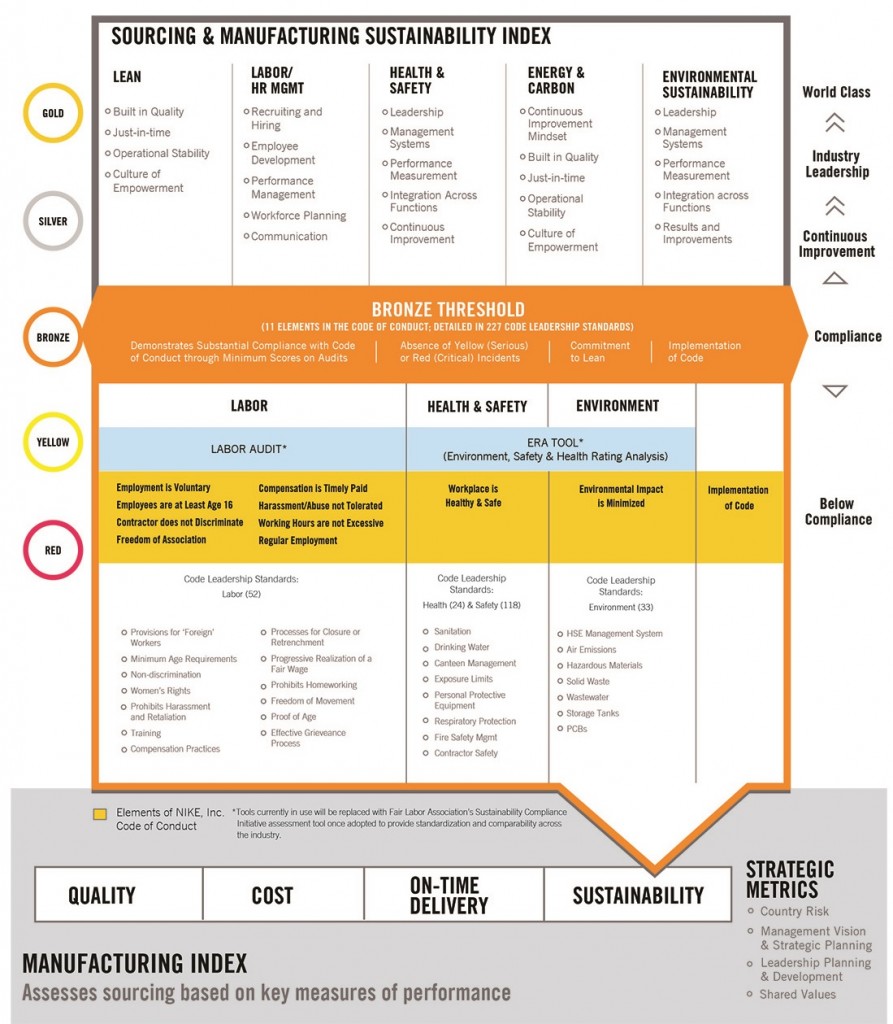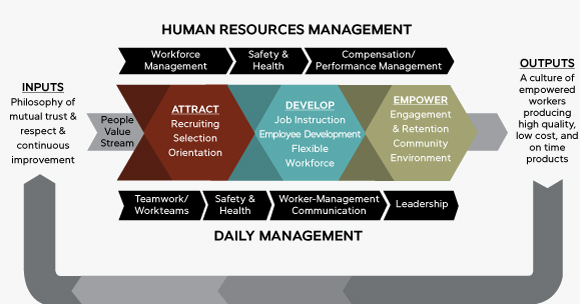I was invited to the Nike Headquarters several months ago, where I met with most of the leadership team of the Nike.com business unit, which is the business unit tasked with growing their direct-to-consumer business. I was very, very impressed to see their commitment to Lean and was pleasantly surprised at how far up and how deeply down the commitment to Lean is at Nike. This article will provide an overview of Nike Lean Manufacturing, the business units involved, and how they are tracking progress thus far.

But, wait, real quick here’s a picture of my waiting in the lobby – that’s my water bottle and notebook on the table. . .and, as a side note, the day I was at the Nike Campus, Kobe Bryant was in the cafeteria hanging out. I didn’t get a picture with him, but I could have thrown my bowl of Thai Noodles at him – he was that close.
Reputation Management to Innovation Opportunity
Nike’s manufacturing footprint is huge. As of this writing, they have manufacturing contracts with over 785 factories, across India, Vietnam, Philippines, and South America. And, over the years Nike has been criticized for its lack of oversight of its manufacturers. Initially, they approached the problem as a way to manage reputation. But, now they are seeing their oversight and relationship with contract manufacturers as an opportunity to innovate.
But innovation isn’t in a vacuum. Innovation at Nike must be within the context of (a) serving the athlete, (b) grows the company, and (c) delivers inspiration. While you won’t see Lean lingo, the context matters. This is effectively Nike’s “True North” if we were to speak in terms of Hoshin Kanri.
Nike has 2 overarching goals in their strategy:
- Make Today Better
- Design the Future
Pretty simple and can easily be remembered by all employees. Under these two main pillars in their strategy, Lean begins to take context.
Design the Future: Nike Lean Manufacturing
Nike has determined that their finished goods manufacturing is where they have the largest impact on people and the environment. Within that context, they want to be a catalyst for positive change. Consider these numbers:
- 785 Contract Manufacturers
- Over 1 Million factory workers
- More than 500,000 unique products
Those numbers are staggering and humbling at the same time.
Factory Sourcing
Quality begins at Factory Sourcing – that is, the process a contract manufacturer has to enter in order to be selected as a Nike manufacturing partner. The sourcing process is more rigorous than it was and Nike has improved the quality of the manufacturing partner and the time it takes to select a partner.
In terms of time it takes to become a partner, it now takes Nike 152 days versus 246 days. That means it takes Nike 38% less time evaluating a manufacturing partner. This is a massive improvement.
In terms of quality, Nike has increased its requirements but doesn’t leave the partner hanging dry – Nike actually spends time and energy and resources helping the contract manufacturing partner reach Nike’s new standards. As of this writing, Nike has 0 manufacturers in Gold, 1 manufacturer in Silver, 535 in Bronze, 156 manufacturers in Yellow, 77 contract manufacturers in Red. As you can see, Nike’s bar of excellence is high and Nike actively not only audits its manufacturing partners, but also helps them improve 1.

Manufacturing Excellence
According to Nike, in order to design the future, Lean Manufacturing must be part of the solution for them. In their words,
Lean manufacturing has been a hallmark of our approach with factories and is the foundation of how we advance sustainable manufacturing. Lean manufacturing is a business system and continuous improvement philosophy that aims to deliver the highest-quality product while eliminating waste, including lost time and material. At Nike, we also believe lean can empower workers and teams. The success of the lean approach depends on the implementation of physical changes to production processes, increased leadership capabilities and the development of an empowered workforce. Lean manufacturing seeks to engage the minds of those closest to the work to solve the problems that prevent them from delivering quality product on time, every time.
As we all know, people are at the heart of any operation. Nike has spent a lot of energy in training and upskilling their contract manufacturers in Lean. From their perspective, Lean helps their people in the following ways:
- Leadership: factory leaders use Lean to drive business performance
- People: workers are engaged and enabled to drive business success through continuous improvement
- Process: factory processes are predictable and agile in response to customer demand
And, they believe that
The lean approach also seeks to engage the minds of those closest to the work to solve the problems that prevent them from delivering quality product on time, every time.
In fact, they use Jeffrey Liker’s model found in his book “Toyota Culture, the Heart and Soul of the Toyota Way” as an example of how they need to align people and strategy and lean in their training.

I have to say that this is the aspect of the Lean deployment that impresses me the most. Why? Most organizations will start Lean primarily in the Daily Management section of the model and it stays there. Most of us know this as Shop Floor Management, or even the Toyota Floor Management Development System as I know it.
But at Nike, they go deeper and higher and more broadly. In their words, this is how training is done in order to help their people – notice the level of Lean Six Sigma Training conducted 2:
The curriculum contains 10 modules that each focus on a key area of the Culture of Empowerment Model. Each module is designed to share HRM best practices related to lean manufacturing, and contains interactive exercises that allow factory managers to assess their current state and identify improvement opportunities in areas including recruiting, selection, employee development, performance management, worker-management communication and retention.
The curriculum also contains instruction and exercises on lean problem solving and planning tools including PDCA (plan, do, check, act) and A3 reports, which facilitates knowledge sharing and collaboration in a concise document. These tools are used throughout the capacity building to define follow-up projects that factory managers implement after completing the training.
And, they also take temperature checks with their people, to see if the Lean deployment is meeting their needs. In a survey conducted by an outside firm, the results seem promising and Nike has also take this data from survey results to help further improve their people operations:

And, as with most organizations that are focused on continually improving, Nike is doing that and hold themselves accountable. As of this writing, here is their assessment of their Lean journey so far:

In conclusion, I applaud Nike’s commitment to making Lean Manufacturing part of their strategy. Notice that Lean is not an end in itself, but is an aid to further progress toward meeting the Nike promise and achieving their goals and strategy.
Here’s an older video of their fulfillment and distribution operations – a part of their supply chain. Keep in mind, this is before they Lean Journey. It’s interesting nonetheless.
The post Nike Lean Manufacturing: An Example of Good Policy Deployment appeared first on shmula.